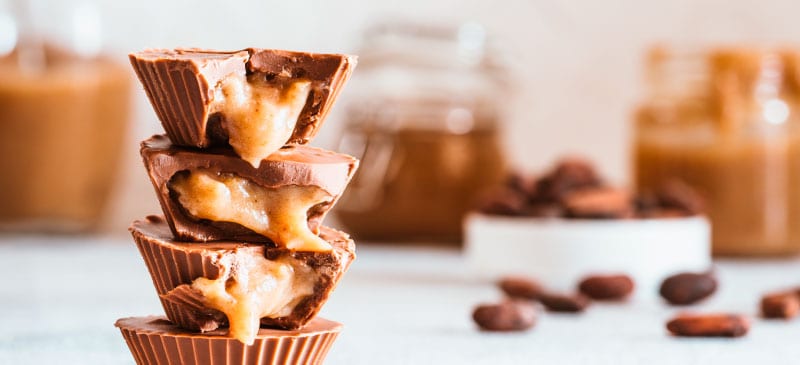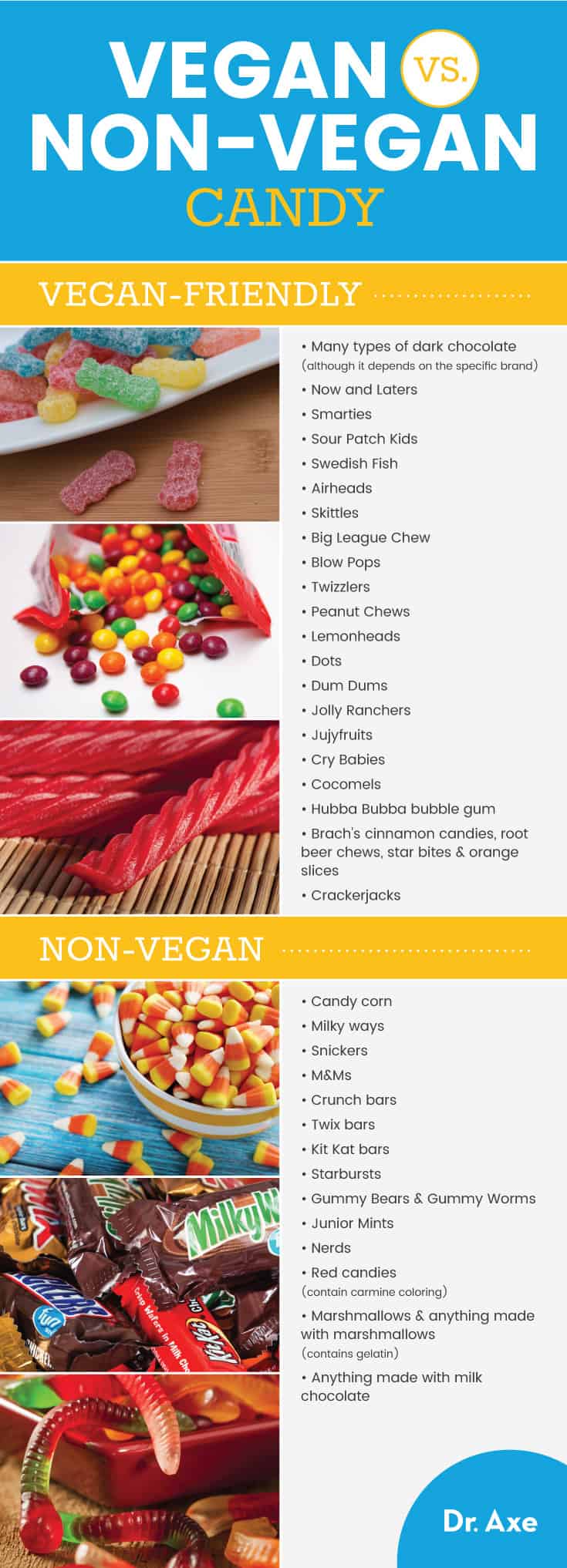Can Vegans Eat Candy? (original) (raw)
Fact Checked
This Dr. Axe content is medically reviewed or fact checked to ensure factually accurate information.
With strict editorial sourcing guidelines, we only link to academic research institutions, reputable media sites and, when research is available, medically peer-reviewed studies. Note that the numbers in parentheses (1, 2, etc.) are clickable links to these studies.
The information in our articles is NOT intended to replace a one-on-one relationship with a qualified health care professional and is not intended as medical advice.
This article is based on scientific evidence, written by experts and fact checked by our trained editorial staff. Note that the numbers in parentheses (1, 2, etc.) are clickable links to medically peer-reviewed studies.
Our team includes licensed nutritionists and dietitians, certified health education specialists, as well as certified strength and conditioning specialists, personal trainers and corrective exercise specialists. Our team aims to be not only thorough with its research, but also objective and unbiased.
The information in our articles is NOT intended to replace a one-on-one relationship with a qualified health care professional and is not intended as medical advice.
Top Vegan Candy Options, Plus Recipes to Make Your Own
October 29, 2024
- What is vegan candy?
- Which candies are vegan?
- Why you should still limit/avoid vegan candy
- How to make homemade vegan candy

If you follow a vegan diet, you’re probably already used to checking ingredient labels carefully and skipping any treats that you suspect might not be totally plant-based. Many vegans make a strong effort to eat a nutrient-dense diet overall, but this doesn’t mean they never want to indulge in something like dessert or candy occasionally — yet it’s not always so easy to find true vegan candy.
Surprisingly, many types of candies and desserts contain ingredients made from animal parts, even fruit candies that contain no visible dairy or milk chocolate.
What can vegans eat to satisfy a craving for sweets? Read on to find out about more than 20 different vegan candy options, plus ways you can make your own.
What is vegan candy?
You may wonder: What makes a candy vegan?
Vegan candy is made without any ingredients that are derived from animals, including any type of milk or dairy product, gelatin, butter, lard, or insect-derived food coloring.
Ad
Candies that are vegan use alternatives for the animal-derived (non-vegan) ingredient called gelatin. Gelatin is a common additive in candies that is made from animal collagen, which is a type of protein found in animal and human skin, connective tissue, ligaments and bones.
Gelatin that is used in food products is usually derived from pigs or cattle. Adding gelatin to recipes helps form a gel-like consistency that gives candy, and some desserts like Jell-O or custard, a chewy and silky texture.
It’s also used as a thickener, binder and stabilizer in many other processed foods besides candy — including confectionary snacks, cakes, wine, fruit juice, and some meat or meat-alternative products (that are not vegan).
Even though these types of highly processed foods are certainly not very healthy, gelatin itself is not a harmful ingredient. In fact, gelatin has many benefits, such as helping:
- provide amino acids like glycine
- strengthen the gut lining
- improve digestive health
- restore joint health
- improve the condition of the skin
That being said, you still might choose to avoid all sources of gelatin for other reasons, such as due to ethical or environmental concerns.
Besides gelatin and milk/cream, other animal-derived ingredients found in certain candies that are not vegan include:
- Food-coloring agents/dyes, such as carmine. According to PETA, carmine is a red pigment made from the crushed female cochineal insect.
- Shellac, which is sometimes called confectioner’s glaze. Shellac is made from insects and used to add a glossy coating to candies.
- Certain types of sugars made with bone char, which is derived from bones of cattle and used as a decolorizing filter to help make sugar very white. Bone char is found in some brown sugars, and confectioner’s sugar is sometimes called “natural carbon.”
- Lard or butter, types of fats that might be used in homemade candy recipes or baked goods.
Which candies are vegan?
Based on their ingredients, these candies ARE vegan:
- Many types of dark chocolate (although it depends on the specific brand)
- Now and Laters
- Smarties
- Sour Patch Kids
- Swedish Fish
- Airheads
- Skittles
- Big League Chew
- Blow Pops
- Twizzlers
- Peanut Chews
- Lemonheads
- Dots
- Dum Dums
- Jolly Ranchers
- Jujyfruits
- Cry Babies
- Cocomels
- Hubba Bubba bubble gum
- Brach’s cinnamon candies, root beer chews, star bites and orange slices
- Crackerjacks
- Sweet Tarts

These candies are NOT vegan:
- Candy corn
- Milky Way
- Snickers
- M&Ms
- Crunch bars
- Twix bars
- Kit Kat bars
- Starbursts
- Gummy Bears and Gummy Worms
- Junior Mints
- Nerds
- Red candies (contain carmine coloring)
- Marshmallows and anything made with marshmallows (contains gelatin)
- Anything made with milk chocolate
Since chocolate is one of the most popular types of candy/sweets, you might be wondering which types of chocolate are vegan and which are not?
Most dark chocolate IS vegan, but not all types are. Almost always milk chocolate is not vegan.
Caramel, vanilla and butterscotch candies or bars may or may not be vegan, so you’ll need to check the ingredients to know. Check ingredient lists and look for additives, including whey, milk solids, milk, cream, butter or other dairy-derived ingredients that are not vegan.
Also, if you’re concerned about purchasing fair-trade, quality products then you’ll want to purchase from brands that produce organic, fair-trade chocolate. You can look at the Food Empowerment Project’s website to learn more about which types of chocolate meet the criteria.
Why you should still limit/avoid vegan candy
Certain candies might be vegan-friendly, but that doesn’t mean they are good for you or things to include in your diet regularly. The bottom line on all candy is that it’s little more than empty calories and a source of added sugar — from the worst Halloween candy to the varieties that are a little better for you.
Now and then having a small amount of candy might not be the biggest deal, but it’s not something to make a regular habit.
If you are going to occasionally eat candy, try not to keep any in plain sight in your home or office, such as in a see-through container or an open bowel, which will only make you feel more tempted to keep eating it.
You can also reduce the likelihood that you’ll overindulge by eating individually wrapped portions of candy as opposed to snacking from a big bag.
There are hundreds of different candies available depending on where you live and shop, so it would be impossible to list all of the types that are vegan and all the types that are not. Food manufacturers also change their ingredients and processing techniques from time to time, so the lists above of vegan and non-vegan candies may eventually change.
Ad
The best way to find out which types of ingredients and additives are in the foods you’re eating is to check the manufacturer’s website for more details. Remember that limiting the amount of processed foods in your diet and replacing them with simple homemade recipes is the best way to avoid eating processed ingredients in the first place.
Healthier vegan candy options/recipes
Are there any vegan candy options that might actually have some health benefits? Probably not, which is why limiting your portions of any type of candy (vegan or not) is the best approach.
If you’re looking for a way to enjoy other types of vegan sweets besides candy, consider making vegan desserts that do have some health benefits — for example:
- Energy balls/bites
- Strawberries or pineapple dipped in vegan dark chocolate
- Dark chocolate covered mini pretzels
- Coconut chocolate pudding or mousse
- Vanilla chia pudding made with almond, cashew or coconut milk
- Avocado chocolate mousse
- Vegan chocolate chip cookies or oatmeal cookies
- Protein peanut butter fudge recipe
How to make homemade vegan candy
If you’re a vegetarian or vegan and you want to try making homemade vegan candy, One Green Planet is a good source for inspiration. For example, its recipe for vegan candy corn uses non-dairy milk, vegan butter (you can also use coconut oil) and vegan sugar.
When making vegan candy you’ll want to use another type of plant-based ingredient in place of gelatin that helps form a similar texture. The goal is to use an ingredient that helps control viscosity and provides a good “mouth feel” but is still plant-derived.
Several plant-based gelatin alternatives can be found in certain health food stores or online. These ingredients can also be used when making other vegan desserts besides candy, such as custards, jello or mouses.
Most gelatin alternatives need to be dissolved and soaked in water in order for them to help develop the right texture. You can read directions of the specific product you choose to use for more help with getting the best results.
Examples of vegan substitutes for gelatin include:
- Agar agar — available in powder or flake form, made from algae and tasteless. Use 1 teaspoon of agar powder (or 1 tablespoon of agar flakes) in place of one teaspoon of gelatin in recipes.
- Vegan gel — manmade “vegetable gum” from compounds like adipic acid, tapioca dextrin, calcium phosphate and potassium citrate. Roughly, 1 teaspoon gelatin is about 1.5 teaspoons vegan gel. (Read the directions for best results.)
- Depending on the recipe you’re making, possibly locust bean gum, pectin or xanthan gum (all considered vegetable-derived “gelling agents”).
- Because it’s been linked with certain side effects, I wouldn’t recommend using carrageenan.
To avoid all bone char that is sometimes found in sugar, be sure to purchase sugar that is certified vegan. Beet sugar and coconut sugar are normally vegan as they don’t require the use of activated carbon.
Raw cane sugar, maple syrup, molasses and stevia can also be used in most vegan candy/dessert recipes (but remember that honey is not vegan).
Conclusion
- Vegan candy is made without any ingredients that are derived from animals, including any type of milk or dairy product, gelatin, butter, lard, or insect-derived coloring agents/dyes.
- Examples of vegan candy include Smarties, Sour Patch Kids, Swedish Fish, Airheads, Skittles, Blow Pops and Twizzlers.
- Examples of candies that are not vegan include milk chocolate, Snickers, Crunch bars, Twix, Junior Mints, Starbursts and Nerds.
- Limit the amount of any candy you eat by sticking with one or two pieces of small, individually sized, portioned candies occasionally.
- Consider making your own vegan sweet treats at home, such as vegan fudge or energy balls, in order to control the ingredients.
